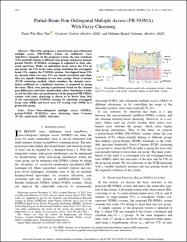| dc.contributor.author | Thet, Nann Win Moe | |
| dc.contributor.author | Özdemir, Mehmet Kemal | |
| dc.date.accessioned | 2021-07-02T07:33:09Z | |
| dc.date.available | 2021-07-02T07:33:09Z | |
| dc.date.issued | 2021 | en_US |
| dc.identifier.citation | Thet, N. W. M. ve Özdemir, M. K. (2021). Partial-beam non-orthogonal multiple access (PB-NOMA) with fuzzy clustering. IEEE Wireless Communications Letters, 10(6), 1202-1206. https://dx.doi.org/10.1109/LWC.2021.3061779 | en_US |
| dc.identifier.issn | 2162-2337 | |
| dc.identifier.issn | 2162-2345 | |
| dc.identifier.uri | https://dx.doi.org/10.1109/LWC.2021.3061779 | |
| dc.identifier.uri | https://hdl.handle.net/20.500.12511/7431 | |
| dc.description.abstract | This letter proposes a partial-beam non-orthogonal multiple access (PB-NOMA) system for millimeter wave (mmWave) channels. In the proposed system, the user terminals (UT)s partially belong to different user groups and power-domain partial NOMA (P-NOMA) technique is exploited in their allocated spectrum. While an individual beam serves the UTs in one group, the UTs in the same group, including the overlapped beam UTs, employ the P-NOMA scheme. Overlapped beam UTs are present when two near UTs are closely correlated and when they are equally belonging to two user groups. Fuzzy C-means (FCM) clustering method, which considers the channel correlation coefficient as a similarity measure, is proposed to group the users. Then, user pairing is performed based on the channel gain differences and fuzzy membership values. Simulation results reveal that the sum-rate performance of the proposed PB-NOMA scheme with fuzzy clustering is shown to be better than that of the conventional P-NOMA systems by adjusting overlapped beam ratio (OBR) and lower near UT overlap ratio (NOR) in a preferable group. | en_US |
| dc.description.sponsorship | Graduate Scholarship Program for International Students | en_US |
| dc.language.iso | eng | en_US |
| dc.publisher | IEEE-Institute of Electrical and Electronics Engineers Inc. | en_US |
| dc.rights | info:eu-repo/semantics/embargoedAccess | en_US |
| dc.subject | NOMA | en_US |
| dc.subject | Interference | en_US |
| dc.subject | Bandwidth | en_US |
| dc.subject | Array Signal Processing | en_US |
| dc.subject | Silicon Carbide | en_US |
| dc.subject | Signal to Noise Ratio | en_US |
| dc.subject | Resource Management | en_US |
| dc.subject | Non-Orthogonal Multiple Access (NOMA) | en_US |
| dc.subject | Partial-NOMA (P-NOMA) | en_US |
| dc.subject | User Clustering | en_US |
| dc.subject | Fuzzy C-Means (FCM) | en_US |
| dc.subject | Multi-Users MISO | en_US |
| dc.subject | Side-Lobes | en_US |
| dc.title | Partial-beam non-orthogonal multiple access (PB-NOMA) with fuzzy clustering | en_US |
| dc.type | article | en_US |
| dc.relation.ispartof | IEEE Wireless Communications Letters | en_US |
| dc.department | İstanbul Medipol Üniversitesi, Mühendislik ve Doğa Bilimleri Fakültesi, Elektrik ve Elektronik Mühendisliği Bölümü | en_US |
| dc.authorid | 0000-0002-9193-1374 | en_US |
| dc.authorid | 0000-0002-9054-0005 | en_US |
| dc.identifier.volume | 10 | en_US |
| dc.identifier.issue | 6 | en_US |
| dc.identifier.startpage | 1202 | en_US |
| dc.identifier.endpage | 1206 | en_US |
| dc.relation.tubitak | info:eu-repo/grantAgreement/TUBITAK/SOBAG/215E316 | |
| dc.relation.publicationcategory | Makale - Uluslararası Hakemli Dergi - Kurum Öğretim Elemanı | en_US |
| dc.identifier.doi | 10.1109/LWC.2021.3061779 | en_US |
| dc.identifier.wosquality | Q1 | en_US |
| dc.identifier.scopusquality | Q1 | en_US |


















